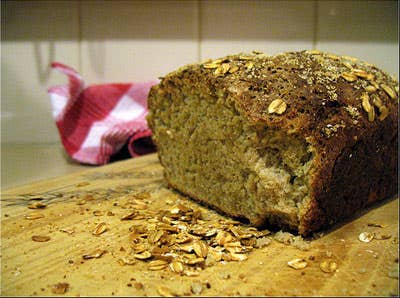
Local Grains
When we shop at the farmer's market, as far as we know at least, we're shopping local. That's an easy concept to understand with vegetables, but how about with baked goods? Recently, at New York's Greenmarket in Union Square, I paid an extra visit to the bread stands to find out exactly what makes bread "local."
The answer, it turns out, is in flux. Until recently, the primary set requirement for Greenmarket bread was that it be baked in state (though organizers have always encouraged the use of local products in baked goods). Starting this year, the market will roll out stricter guidelines that will better showcase locally produced ingredients, like eggs, butter, milk, maple syrup, honey and particularly regional flour.
The Greenmarket's publicity manager, Sabine Hrechdakian, said the new baking rules reflect a growing availability of grain and flour produced in the region. Take Cayuga Pure Organics, the 600-acre, Ithaca-based farm that grows beans and baking flours (wheat, rye, spelt, and polenta among others), as well as whole wheat, farro, barley, freekeh, and buckwheat berries for sprouting, cooking, and beer brewing. "If customers have their own mill, they could grind the berries for flour, too," Cayuga's Sophie Vranian said.
Cayuga joined the Greenmarket last year and is currently the market's only regular vendor of local grains. Its presence, though, is indicative of a larger movement—both in New York and across the country.
Northern California's Eatwell Farm, for example, sells local wheat berries at Bay Area farmers' markets. Wheatberry Bakery in Amherst, Massachusetts uses local grains in several of their products, and started a grain CSA in 2009 that served over 100 families in its pilot season. In Minnesota, Sunrise Flour Mill supplies both whole berries and freshly milled local flours to customers. Many of these grain pioneers are also working to incorporate heirloom grains back into America's breadbaskets.
Even King Arthur Flour, the beloved national company, recently introduced a bread made from local grains in their Vermont-based bakery. According to King Arthur's Bakery Director, Jeffrey Hamelman, the bakery currently produces about 100 loaves of their Vermont Grains bread each week, and customer response has been overwhelmingly positive.
Most of these initiatives are quite new, but they point to the exciting possibility of what regional grain economies could look like in America, not to mention delicious products—local breads, pastries, pasta, and even beer—that could result. "In recent years, we've seen grass-fed meat take off," Hrechdakian said. "I think grains and flour are the next frontier in local eating."
Until I decide to abandon the city for greener (and grain-ier) pastures, my kitchen is the best place to tap into the local grains movement. Luckily, bread baking is the perfect Sunday afternoon pastime, and most breads—from a hearty Irish brown bread to sweet cinnamon orange swirl bread, a rustic oatmeal buttermilk loaf, or a truly decadent white truffle walnut bread--freeze well and can be enjoyed all week long.
Buying Tips
Season: Different grains are harvested at different times of year, but because grain and flours store well, they can be used year-round. For the freshest flour, buy whole wheat berries and grind them yourself right before use.
Where to find it: The movement is still small, but it's growing quickly. Ask your local your farmers' market organizers about their standards for bread producers and whether the market includes local flour vendors. You can also inquire at your local bakery about any work they are doing to incorporate local grains - chances are, it's already on their radar screen!
Price: Farmers' market bread tends to range between $3-$6/loaf depending on ingredients. Cayuga sells their 2 lb. bags of white, half-white, and whole-wheat flours under the brand name Farmer Ground Flour (which they co-founded with Oescher Farms) for $5 a piece, while specialty flours like polenta sell for $6 for a 2 lb. bag. —Leah Koenig
Keep Reading
Continue to Next Story










